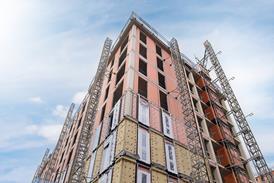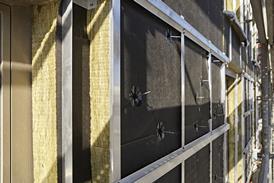It is now subject to different circumstances, that are leading to sector-specific changes. But the interests of the m&e contracting industry cover a diverse range of the construction market, so it serves virtually all sectors of the community and economy. In consequence, the overall development of the industry tends to reflect the economic activity of the country.
New work in the commercial construction sector is the mainstay of the mechanical and electrical contractor market in the UK. Between 1997 and 2000, MBD calculates that on the mechanical contracting side, nominal growth of 55% took output to £1915 million. Similarly, electrical contracting saw 62% growth from '97 to 2000.
The latest MBD report predicts that growth in m&e contracting will continue, but in the short term economic difficulties in the UK, and changes in construction activity will restrict growth to around 2% in real terms. (See tables 1 and 2) Mechanical contracting output for new public construction projects outside the residential sector, is expected to increase in 2002 by 3%, offsetting the reduction in 2001. But after that, prospects are poorer, with output likely to fall by 3% up to 2006. More specifically, the prediction is that turnover for the mechanical contracting in the new commercial construction sector will fall to £1909 million in 2004. A strong recovery will return output in 2006 to the level expected in 2002.
In the private housing market, mechanical contracting activity has increased each year between 1997 and 2000, and nominal growth of 28% was achieved in this period. Evidence for 2001 is that output has declined by 5% to £656 million, a level still in excess of years prior to 2000.
Conversely, mechanical contracting in the public sector housing market has experienced more erratic trends. Output declined between 1997 and 1999 by 17%. However, there was a 29% increase during 2000, and growth in 2001 appears to have reached around 7%.
The lead up to the millennium saw mechanical contracting output in the public new construction area increase by 36% between 1997 and 1999. Output has dropped by a nominal 2% in 2000, and a further drop in 2001.
For electrical contractors, as for mechanical, the commercial construction sector has provided a consistent and growing area of work.
MBD predicts that for electrical contractors, the public housing sector is likely to prove a buoyant market. Predicted growth between 2002 and 2006 is expected to reach 23% in real terms, following growth of 4% in 2002.
In the new private housing sector, however, while there was growth of 31% between 1997 and 2000, the following year saw a decline, even in nominal terms, of 5%. Similarly, electrical contracting in the new public construction market declined from £642 million in 1999 to £626 million in 2001.
For contractors, the repair and maintenance market represents a stable source of income for both electrical and mechanical (see table 4). On the mechanical side, repair and maintenance in the private industrial and commercial sectors has grown over the past five years. In 2001, output is estimated at £1855 million, which is 41% higher than in 1997.
In the same sector, electrical contractors have experienced growth of 48% between 1997 and 2001, with 22% growth in 2001 alone. And between 2001 and 2006, MBD estimates output growth in real terms of 16%.
The total market for m&e contracting in Britain reached £16 082 million in 2000, representing nominal growth of 5% in that year. Estimated growth for 2001 is 6%, taking output to £17 018 million. Within the MBD review period, 1997 to 2001, the proportional importance of mechanical and electrical contracting has not materially changed. (See table 3).
However, a decline in output is estimated although MBD speculates that this is almost certainly reflected in the timing of projects rather than a long-term trend. As a result, the private commercial sector recorded growth in 2001, but the rate of growth continues to be relatively low (4%).
Within the private commercial construction sector, offices remain key to industry growth. According to MBD, this sector may be facing an increasingly difficult time as the economy comes under pressure. Speculative office construction has shrunk, leaving the sector dependent on total economic activity.
Like the rest of construction, m&e contracting is likely to benefit from any increased public spending. The Chancellor's announcement in March 2001 that public spending would increase has been much quoted.
According to the Institute for Fiscal Studies, public spending growth in 2001 could be the highest in the generation, with the Institute identifying that the government has the capacity to increase spending by 10%.
However, for the fourth year running, figures show that government departments have failed to spend all the cash allocated to them. The shortfall from budget in 2001 was £6200 million. Significantly, the key underspending departments include those where government attention is supposedly focused: education and unemployment (underspent by £1.4 million); and the Department of Health (underspent by more than £500 million).
But the underspending will, in theory, be counteracted by extra expenditure in 2001. In addition to making up last year's shortfall, the Treasury is allowing departments to carry forwards £6700 million of underspending from previous years. Figures available later this year should in theory show a resulting 10% increase in 2001.
Private commercial construction was in a period of rapid growth between 1996 and 1999. In 2000, this level of growth was reduced, although, PFI funding contributed to growth in the education and health sectors of private construction. Between 1997 and 2000, output was increased by 230% through PFI funding. A further growth of 63% is estimated for 2001. (See chart).
Overall, the mechanical and electrical contracting sector looks set to ride out future fluctuations in the construction industry, with increased public spending hopefully having a positive impact across the board. It may also turn out that in the mechanical and electrical contracting sector, the repair and maintenance market will prove lucrative as clients look to save money by better maintenance of their facilities.
Downloads
Source
Building Sustainable Design
Postscript
Market Watch is based on data supplied by Market & Business Development. For more information on MBD reports, see their website www.mbdltd.co.uk, or call on 0161 247 8600





















No comments yet